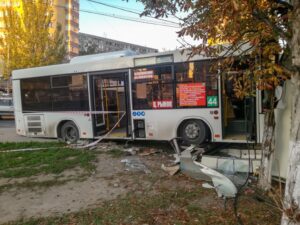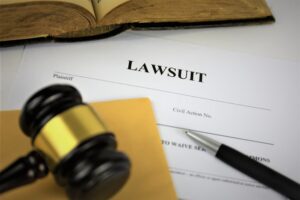Can I Sue the City If I Was Hit by a City Bus?
Can I Sue the City If I Was Hit by a City Bus?
When city bus drivers and other individuals drive in a negligent, careless, or reckless manner, serious pedestrian accidents may occur. If a large, heavy bus strikes a pedestrian, and the pedestrian hits the ground with significant force, they may suffer extremely serious and debilitating injuries.
If you or a loved one suffered injuries in a pedestrian accident involving a city bus, you need to retain the legal help that you need as quickly as possible. An experienced bus accident attorney in your area can review the police report and investigate your accident circumstances. Your lawyer may then file a claim against the city or other individual or entity, seeking the compensation you need for your injuries.
Common Injuries in a City Bus Accident

When a city bus collides with pedestrians or other individuals, the resulting injuries can be severe and diverse, involving various parts of the body and affecting victims in unique ways. Such accidents often lead to a range of injuries that may affect the physical, emotional, and financial well-being of those involved.
One of the most common injuries resulting from a city bus collision is trauma to the lower extremities. The sheer force of impact can cause fractures, sprains, or dislocations in pedestrians’ legs, knees, or ankles. The vulnerability of these areas to direct contact with the bus or secondary impacts with the ground can result in significant musculoskeletal injuries.
Head injuries are another grave consequence when a city bus hits individuals. The head, a particularly vulnerable part of the body, is at risk of striking the bus or the pavement during a collision. Traumatic brain injuries (TBIs) may occur, ranging from concussions to more severe conditions that can have long-term cognitive and neurological consequences.
Upper body injuries, including injuries to the chest, shoulders, and arms, are also common in such accidents. Impact on the bus or surrounding structures can lead to fractures, contusions, or internal injuries in these areas. In severe cases, injuries to vital organs may occur, presenting life-threatening complications.
Back and spinal injuries are also prevalent due to the force exerted on individuals during a bus collision. The sudden jolt or impact may cause herniated discs, fractures, or damage to the spinal cord. These injuries can result in long-term physical disabilities, affecting mobility and overall quality of life for the victims.
Soft tissue injuries, such as bruises, lacerations, and abrasions, are widespread. The force of impact or contact with the bus can cause these injuries, varying in severity depending on the nature of the collision.
Psychological trauma is an often-overlooked consequence of a bus-pedestrian accident. The emotional distress resulting from such a traumatic event can lead to conditions like post-traumatic stress disorder (PTSD), anxiety, or depression, affecting the mental well-being of the individuals involved.
In addition to the physical and emotional toll, victims may face financial burdens due to medical expenses, lost income, and ongoing rehabilitation costs. The aftermath of a city bus collision underscores the need for comprehensive medical attention, legal support, and rehabilitation services to address the multifaceted challenges faced by those who have suffered injuries in such accidents.
Where Do City Bus Accidents Occur?
City bus accidents involving pedestrians can occur in various locations, presenting unique challenges and risk factors. Some common sites for such accidents are as follows:
- Intersections — One common site for such accidents is at intersections, where multiple roadways intersect, creating complex traffic dynamics. Pedestrians navigating crosswalks or streets may be vulnerable to bus accidents, particularly if drivers fail to yield or adhere to traffic signals.
- Urban Areas — Urban areas with heavy pedestrian traffic, such as downtown districts or bustling city centers, are also susceptible to bus accidents. The density of foot traffic and the presence of buses maneuvering through crowded streets increase the likelihood of collisions. Busy city centers may see accidents when pedestrians cross streets and buses make turns or navigate through congested areas.
- Residential Neighborhoods — Residential neighborhoods, especially those with schools or public spaces, can also be locations where bus-pedestrian accidents occur. Children walking to school or playing near bus stops may be at increased risk if drivers fail to observe reduced speed limits or exercise caution in areas where pedestrians are likely to be present.
- Crosswalks and Pedestrian Zones — The purpose of crosswalks and pedestrian zones is to enhance pedestrian safety, but they can also become sites for accidents involving city buses. Failure to yield to pedestrians in designated crosswalks or reckless driving behavior within pedestrian zones can lead to collisions with individuals on foot.
- Bus Stops — Bus stops are another prevalent location for accidents involving pedestrians and city buses. Passengers waiting for or disembarking from buses are often near moving vehicles. Bus drivers must exercise caution in these areas, as sudden stops or turns can pose risks to pedestrians near bus stops.
- Terminal Intersections — Intersections near public transportation terminals or stations are other areas where bus-pedestrian accidents can occur. The mix of pedestrians, buses, and other vehicles in these areas demands heightened attention to traffic rules and pedestrian right-of-way to avoid collisions.
- Transit Hubs — In addition, transit hubs and busy transit terminals are locations where buses are near large numbers of pedestrians. Pedestrians navigating these hubs must contend with buses entering and exiting the area, presenting potential risks when bus drivers do not strictly follow safety measures and regulations.
Who Is Responsible for a City Bus Accident?
Determining responsibility in a city bus-pedestrian accident involves comprehensively examining various parties whose actions or negligence may have contributed to the incident. The complexity of urban environments and the shared responsibilities in public transportation scenarios necessitate a nuanced understanding of potential entities at fault.
The transportation authority or agency operating the city bus is a primary entity that may bear responsibility. These organizations are responsible for maintaining the safety of their fleet, ensuring proper training for bus drivers, and adhering to safety regulations. The transportation authority or agency may be accountable if failures in these areas contribute to a bus-pedestrian accident.
Bus drivers also play a pivotal role in the safe operation of city buses, and their actions or negligence can significantly contribute to accidents. Driver errors, such as distracted driving, failure to yield to pedestrians, or reckless behavior, can make the bus driver liable for a collision with a pedestrian.
Furthermore, maintenance contractors or companies responsible for servicing and repairing buses may share responsibility. If inadequate maintenance or faulty repairs contribute to a bus accident, these contractors may be accountable for their role in the incident.
Other motorists on the road can also be responsible for city bus-pedestrian accidents. Drivers of other vehicles may engage in negligent behaviors, such as failing to yield or reckless driving, leading to collisions with buses and pedestrians. In such cases, these drivers may be at fault, and their insurance may be liable for damages.
Urban planners and city authorities also play a role in ensuring safe infrastructure for pedestrians. Inadequate crosswalks, poorly designed intersections, or lack of proper signage may contribute to accidents. In such cases, responsibility may extend to those responsible for urban planning and infrastructure design.
A city bus-pedestrian accident often involves shared responsibility among multiple parties. Identifying and apportioning blame requires a thorough investigation into the circumstances surrounding the incident, including the bus driver’s actions, the transportation authority, maintenance contractors, and other motorists. A knowledgeable bus accident lawyer in your area can review the circumstances of your city bus accident and file a claim against all potentially responsible parties for you.
Filing a Lawsuit Against the City
When injuries occur in the aftermath of a city bus accident, the prospect of filing a lawsuit against the city becomes a complex legal avenue to determine accountability and seek compensation. Navigating this process involves understanding the unique challenges of pursuing legal action against a municipal entity.
The crux of filing a lawsuit against the city revolves around establishing negligence in the operation or maintenance of the city bus. This negligence can manifest in various forms, such as insufficient training for bus drivers, inadequate maintenance of the bus fleet, or negligence in hiring and supervising personnel. Proving negligence requires a thorough investigation into the accident’s circumstances, including eyewitness testimonies, accident reports, and relevant surveillance footage.
The legal process involves complying with specific procedural requirements for lawsuits against municipal entities. This often includes adhering to statutory notice requirements, wherein the injured party must notify the city within a specified timeframe about their intent to file a lawsuit. Failure to adhere to these notice requirements can potentially jeopardize the case.
Injuries sustained in a city bus accident may result in significant medical expenses, lost income, and other damages. Filing a lawsuit seeks to recover these damages, but the legal proceedings against a city entail compliance with sovereign immunity laws, which vary by jurisdiction. Sovereign immunity typically limits the compensation an accident victim can recover and may establish specific procedures for filing claims against the city.
The lawsuit may also contend with challenges related to governmental immunities, which shield government entities from certain liabilities. While sovereign immunity restricts the amount of damages, governmental immunities may provide additional protection to the city, emphasizing the importance of legal experience in navigating these intricate legal nuances.
Engaging legal representation is paramount when pursuing a lawsuit against the city for injuries sustained in a bus accident. A skilled attorney can assess the case’s viability, navigate the complex procedural requirements, and advocate for the injured party’s rights. Their experience becomes especially crucial in addressing the specific legal defenses that municipal entities often employ, ensuring a comprehensive approach to seeking fair compensation for the injuries, losses, and hardships that the accident victim endured in a city bus accident.
Recovering Financial Compensation in a Claim or Lawsuit
When a city bus strikes an individual, the ensuing damages extend beyond immediate medical concerns, encompassing a spectrum of economic and non-economic consequences that shape the overall effect on the victim’s life.

Economic damages represent tangible financial losses that the individual incurred because of the bus accident. Medical expenses are a primary component, covering the costs associated with emergency medical care, hospitalization, surgeries, rehabilitation, and ongoing treatments. These expenses, often substantial, reflect the financial burden of necessary medical interventions to address the injuries sustained in the bus accident.
Lost income and diminished earning capacity constitute another facet of economic damages. The individual may face a temporary or permanent inability to work due to injuries, resulting in a loss of income. This economic consequence extends beyond the accident’s immediate aftermath, considering the potential long-term effect on the individual’s ability to pursue gainful employment.
Property damage may also contribute to economic damages. Personal belongings or valuables damaged in a bus accident, such as electronic devices, clothing, or personal items, can be part of the overall economic compensation the injured individual seeks.
Non-economic damages delve into the intangible toll that the bus accident takes on the individual, involving various aspects that significantly affect the quality of life. Pain and suffering represent a prominent category of non-economic damages, encompassing the physical and emotional distress experienced by the individual. Chronic pain, emotional trauma, and a diminished overall quality of life fall within this realm, and assessing these damages involves considering the enduring consequences on the individual’s well-being.
Emotional distress and mental anguish further extend the scope of non-economic damages. Post-traumatic stress disorder (PTSD), anxiety, and depression may arise from the psychological aftermath of the bus accident, influencing the individual’s overall mental health. Compensation for these non-economic damages acknowledges the profound and lasting consequences for the individual’s emotional state. Furthermore, loss of consortium or companionship may be applicable in cases where the injuries affect the individual’s relationships. The strain on personal relationships due to physical or emotional changes resulting from the bus accident can be another part of non-economic damages.
The economic and non-economic damages resulting from a city bus accident paint a comprehensive picture of the challenges the injured individual faces. Seeking compensation involves addressing not only the quantifiable financial losses but also recognizing the intangible toll on the individual’s well-being, highlighting the importance of a comprehensive approach to assessing and pursuing damages in the aftermath of a bus accident.
Contact an Experienced Bus Accident Lawyer in Your Area Today

Bus Accident Lawyer, Keith More
If you suffered injuries in a city bus accident resulting from a driver or entity’s negligence, you have legal rights and options. A knowledgeable personal injury lawyer in your area can explore your legal options and take the steps necessary to pursue a claim or lawsuit on your behalf. Your lawyer will do everything they can to maximize your overall financial recovery through settlement or litigation in the court system.


